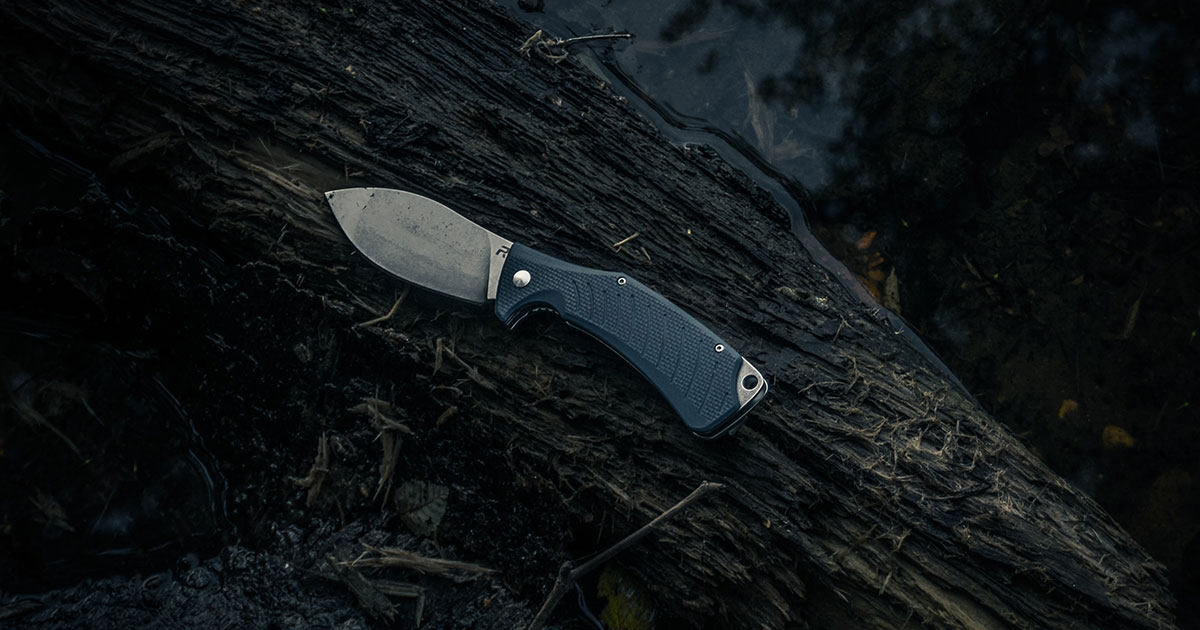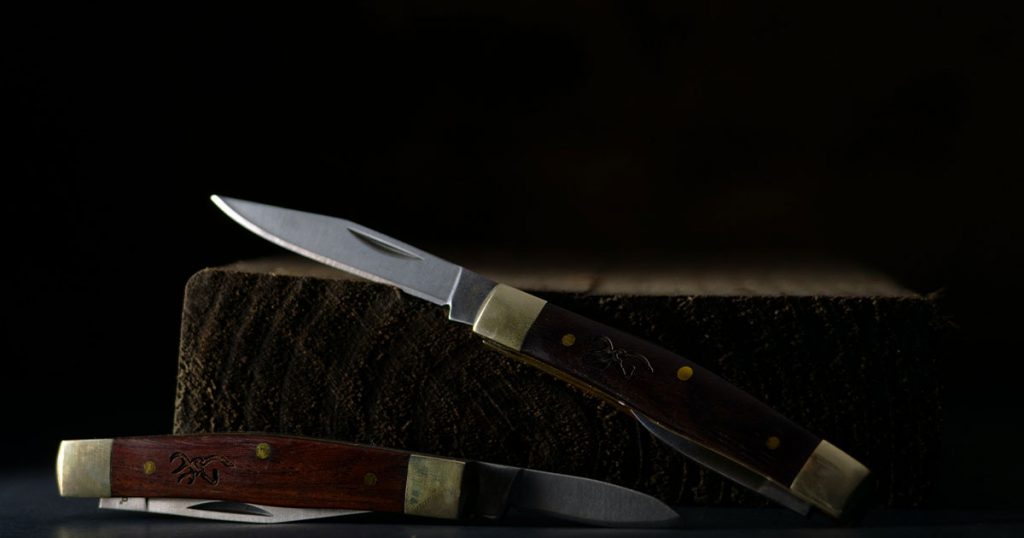Your pocket knife’s blade is dull and rusty. Rust, the enemy of metal, has formed a crusty, flaky coating of corrosion and oxidation, causing it to lose its shine. How did this happen? How can you remove rust from a full carbon steel knife blade?
Rust forms when metal reacts with oxygen, air, water, and moisture in the environment. Even stainless steel knives can form rust, without proper care. Rust spots can make steel pocket knives ineffective and potentially cause illness if you cut yourself with a rusty blade.
Your pocket knife may develop rust over time, but don’t despair. You can restore it with some effort and the right tools. There are many effective methods, from DIY with household items to specialty products. Protect your hands and give your knife the TLC it deserves.

Household Ways to Remove Rust
Cleaning rust off your pocket knife doesn’t have to be expensive. Basic household items like baking soda, steel wool, dish soap, a lemon, or a potato can do the trick. No need to go to the store. We’ll show you a few methods to try at home. If the first round doesn’t work, keep going until the knife is rust-free. So grab those potatoes and start scrubbing!
White Vinegar
Reviving a rusty pocket knife doesn’t have to be expensive. Use distilled white vinegar, which is likely in your neighbor’s pantry. Soak the knife in vinegar and let it work off remaining rust. For stubborn rust, add dish soap to the vinegar. If you’re really on a budget, apply vinegar directly to the blade with a rag or toothbrush. Vinegar is affordable and has acetic acid, which is a powerful rust remover. Say goodbye to rust!
Baking Soda
Baking soda has more uses than making cookies fluffy. It’s also called sodium bicarbonate and can make bread dough rise. It can even remove rust from a pocket knife. Baking powder mix baking soda is not the same thing. Baking soda is a must-have in the kitchen.
Make your metal knives shiny with a homemade baking soda paste. Mix one tablespoon of baking soda with a little water to form a thick paste. Don’t make it too runny or it might slip off the blades. Rub the the excess baking soda paste onto the metal and watch it bring back the shine. Scrub it off and rinse to reveal the transformation in your kitchen. Say goodbye to dull metal and hello to sharp, shiny blades!
Steel Wool
Does your knife have rust? Steel wool can help. It’s abrasive and can remove rust. For tougher spots, try a baking soda paste. Cover a steel wool pad or wire brush with the paste, let it sit, scrub, and rinse. But be careful, steel wool can have rust particles too. Shake off any moisture after use. If all else fails, get a new wire brush.
Raw Potato
Potatoes have oxalic acid, which can remove stains. Oxalic acid is also found in vegetables, leafy greens, fruits, nuts, and seeds. It can remove ink stains, tarnish on metal objects, and rust stains. Surprisingly, potatoes have hidden and surprising properties.
Want to remove rust from your knives? Try using a potato from your kitchen. Just cut it in half and get to work. If that’s not enough, add some dish soap or baking soda. This trick saves you a trip to the store and is a fun experiment for your kids to watch. Say goodbye to rust and hello to kitchen magic.
Salt and Lemon
Salt, vinegar method and lemon can be used to clean rust off blades. Lemon juice acts as a natural bleach and cleaning agent. Pour lemon juice and salt onto the blade, let it sit, then scrub away the rust with more salt. This method is a game-changer for cleaning rusty blades. Limes can also be used. Cleaning has never been so easy and resourceful.
WD-40
If you have a rusty pocket knife, WD-40 can help. This DIY rust removal treatment can also work wonders on blades. Spray your knife with WD-40, wait ten minutes, and then scrub with a wire brush. Your blade will look brand new.
WD-40 can help with rusty knives. Its rust-fighting formula can loosen the bonds between rust and your blade. It also protects entire blade against future corrosion. WD-40 has a special soak for extra rusty knives. No toxic fumes or skin irritation needed – just soak your blade for a few hours or overnight. Your knife will look shiny and new again. Don’t let rust ruin your knife – use WD-40 for a reliable solution.
Other Ways to Bust the Rust From a Pocket Knife
Need to remove rust? Whether it’s heavy-duty or you don’t have the right ingredients, we’ve got you covered. There are plenty of options available online or nearby. Get expert tips on how to optimize and prevent rust formation on your blade.
Rust Remover
Cleaning your knives is easy with these options. You don’t need harsh chemicals or expensive solutions. Make your own DIY cleaner with dish soap or vinegar instead. These gentle options are perfect for those who prefer all-natural alternatives. For stronger solutions, there are rust removers designed for knives and silverware. These rust removers won’t damage your stainless steel knives or precious blades. Simply soak your knife in the cleaning solution or apply it directly onto the blade for more stubborn rust. With so many options available, your knives will look shiny and new in no time!
To get the best results, use the right amount and soak time with product removers. Check the directions first, as each product has different requirements. Water dilution and ready-to-use options both work well. Clean your knife blade beforehand to remove any oil or grease. You can find product removers on Amazon and other online stores. Prices vary from $10 to $30+ per gallon. Upgrade your cleaning game with the best product remover for you.
How Much Rust Is Too Much?
When restoring a pocket knife, rust damage matters. You may find an old knife at a flea market that’s so rusted it’s hard to recognize. Or you might need to fix up some light rust spots on your trusty blade. Expect to carefully scrape or clean if your knife is very rusted. After removing all the rust surface rust, you can clean it more deeply and make it like new again.

Aftercare
To keep your pocket knife in good condition, it’s important to take care of it, even after removing rust. Avoid putting it in the dishwasher and give it some extra attention. Clean it with dish soap and water, then rinse it thoroughly. Check if the blade is still sharp and dry it off. These aftercare steps will keep your knife in great shape for your next outdoor trip.
Rust Prevention
To keep your knife in good condition, take preventative measures against rust. Store it safely away from moisture and heat. With proper care, your knife will last longer and be ready for any culinary adventure.
Protect your prized blade and keep it in optimal condition with a knife display case. Don’t store your knife in a leather sheath for too long, as absorbed moisture can transfer onto the blade. This can leave you a rusty knife with a dull and tarnished edge, so be careful.
Caring for your kitchen knife involves more than just washing it. To maintain its condition, rinse and dry it with a soft cloth or paper towel. If your knife is made of certain types of stainless steel knife made, you can also apply mineral oil for added protection against rust and corrosion. This is especially important for carbon steel knives. Show your kitchen tool the care it deserves!
Do your knife blades need rust removal? No worries! We’ve got expert tips to help you banish rust and keep your knives sharp. You don’t need expensive rust removers – just use dish soap, lemon juice, salt, or a potato. If one method doesn’t work, we have a list of tried-and-true methods. It’s time to take charge and restore your pocket knives to their former glory.
A rusty, dull knife can be transformed into a like-new blade with rust removal. Household hacks and know-how can make rusty red blades shine again. There are products and techniques that work like magic to keep rust forming and restore knives to their glory days, leaving you with a practically brand-new blade for your collection.

